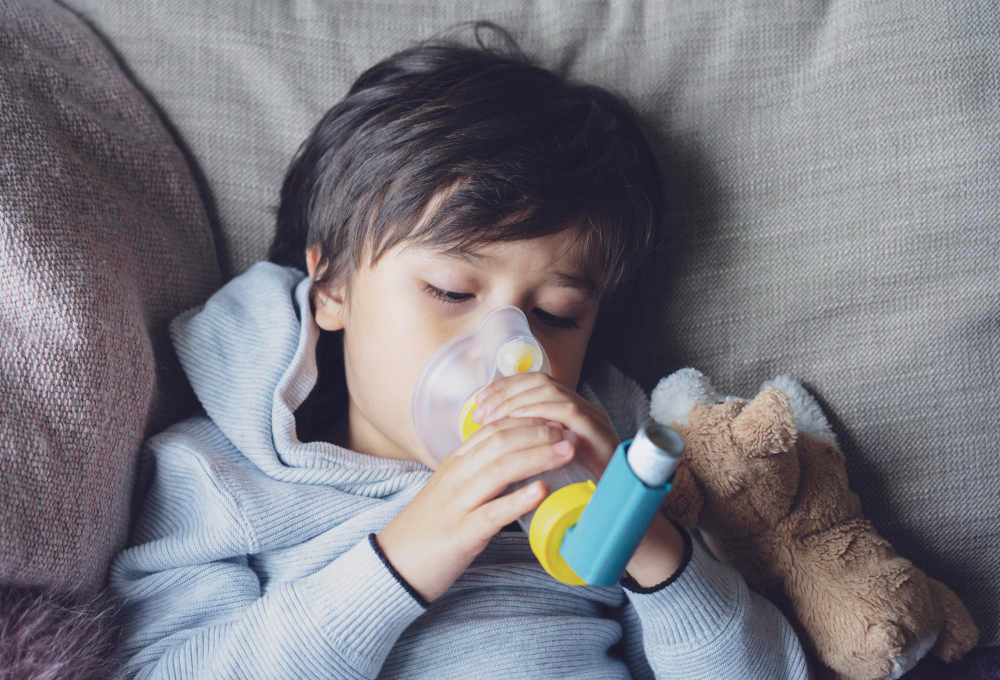Childhood asthma is a common chronic respiratory condition affecting many children. It is particularly prevalent in urban regions of India, where pollution and lifestyle changes are on the rise. As cases of asthma continue to grow, it becomes crucial for parents to understand this condition. A well-informed parent can significantly impact their child’s health and well-being. Recognizing and managing childhood asthma symptoms early can prevent more severe health issues down the line.
Understanding asthma and its impact on children is the first step in safeguarding their future. This guide aims to empower parents with the knowledge they need to identify and manage asthma effectively. By knowing what signs to look for and how to take action, parents can enhance their child’s quality of life. Support and appropriate care can turn asthma from a daily worry into a manageable condition.
Recognizing the Signs and Symptoms of Childhood Asthma
Identifying childhood asthma symptoms early on is key. Some common symptoms include wheezing, which sounds like a musical pitch during breathing, and persistent coughing that may worsen at night or early morning. Shortness of breath, or breathing heavily even when resting, is another indicator. These signs of childhood asthma can sometimes be mistaken for a simple cold or allergy, but they tend to last longer and recur more frequently.
The symptoms can vary with a child’s age. In toddlers, watch for fatigue, irritability, or reduced appetite alongside coughing and wheezing. Older children may express feelings of being “tight” in the chest or struggle to keep up with physical activities. Recognizing these cues specific to their child’s age can be crucial.
Timely identification of these childhood asthma symptoms is vital. Early recognition means parents can seek medical advice and interventions sooner. This proactive approach can reduce the chances and severity of asthma attacks. Seeking guidance from healthcare providers ensures appropriate childhood asthma diagnosis. It constitutes a significant step toward preventing future health complications for the child.
Effective Management and Treatment Strategies at Home
Managing asthma at home effectively starts with following the prescribed medication routine. This ensures symptoms remain under control and that children can enjoy their daily activities. Regular check-ups with healthcare providers are important to adjust treatments as needed.
Creating an Asthma Action Plan is highly beneficial. Work with a healthcare provider to detail what steps to take during normal days and during flare-ups. It provides a structured approach to tackling childhood asthma symptoms as they arise and prevents panic during unexpected asthma attacks.
There are workable home strategies to manage symptoms as well. Parents can:
- Modify activities to ensure children aren’t overly exerted.
- Recognize and avoid triggers like smoke, strong odors, or changes in weather.
- Encourage regular exercise as recommended by a healthcare provider.
In Indian cities, allergens and pollutants can worsen asthma symptoms. Childhood asthma prevention includes minimizing exposure to such irritants. Simple steps like keeping windows closed on high-pollution days, using exhaust fans during cooking, and investing in air purifiers can help.
Adjusting the home environment by reducing dust mites, pet dander, and mold is also recommended. Vacuuming regularly and washing bed linens in hot water can lessen these allergens. Ensuring a clean and dust-free space contributes to better management of childhood asthma symptoms.
By adhering to treatment plans and implementing modification practices, parents empower children to handle asthma with confidence. Building healthy habits means being proactive rather than reactive, ensuring asthma is merely a manageable condition rather than a major disruption.
Addressing Myths and Indian Contextual Influences on Childhood Asthma
In India, misconceptions about asthma abound. Many believe asthma is only due to dust and pollution or think it is something children will inevitably outgrow. Contrary to these myths, asthma can have various triggers not limited to environmental factors.
It’s critical for parents to distinguish between asthma and other conditions, like common colds or allergies, which can exhibit overlapping symptoms. Sometimes these can go untreated due to confusion or misinformation.
There are also cultural practices that help or hinder asthma management. For instance, the use of herbal remedies and traditional healing should be approached with caution and preferably under medical advice.
Socio-economic factors also play a role. Access to healthcare and effective medication can vary. It’s essential for communities to support policies ensuring affordable healthcare services so all children can benefit from proper childhood asthma treatment.
By busting these myths and understanding the wider cultural and social landscape, parents can advocate for and pursue better asthma care for their children. Becoming informed ensures a safer and healthier environment addressing childhood asthma symptoms effectively.
In summary, understanding the signs and management of asthma empowers parents to foster healthier and happier lives for their children. With knowledge and proactive care, asthma becomes a condition that is not feared, but managed successfully.

